Zara's Australian Market Expansion: A Business Report
VerifiedAdded on 2019/09/30
|10
|2521
|339
Report
AI Summary
This report provides a comprehensive analysis of Zara's expansion into the Australian market. It begins with an executive summary and an introduction to Zara as a leading brand in the apparel industry, owned by Inditex. The report then delves into the broader context of the apparel industry, highlighting its growth, global market dynamics, and the impact of liberalization. A significant portion of the report focuses on the regulatory frameworks affecting multinational companies (MNCs) in Australia, including the roles of the ACCC, ASIC, and APRA, as well as the influence of corporate law. It examines the limitations to Zara's strategic freedom imposed by the Australian government, such as sales and export volume conditions. The report also explores threats to managerial autonomy, government influence, and the impact of treaties and agreements, such as the Goods and Services Tax (GST) and labor safety accords, on Zara's business. The conclusion summarizes the key findings and emphasizes the importance of cooperation between host governments and guest companies for mutual benefit. The report utilizes several sources to support its claims.
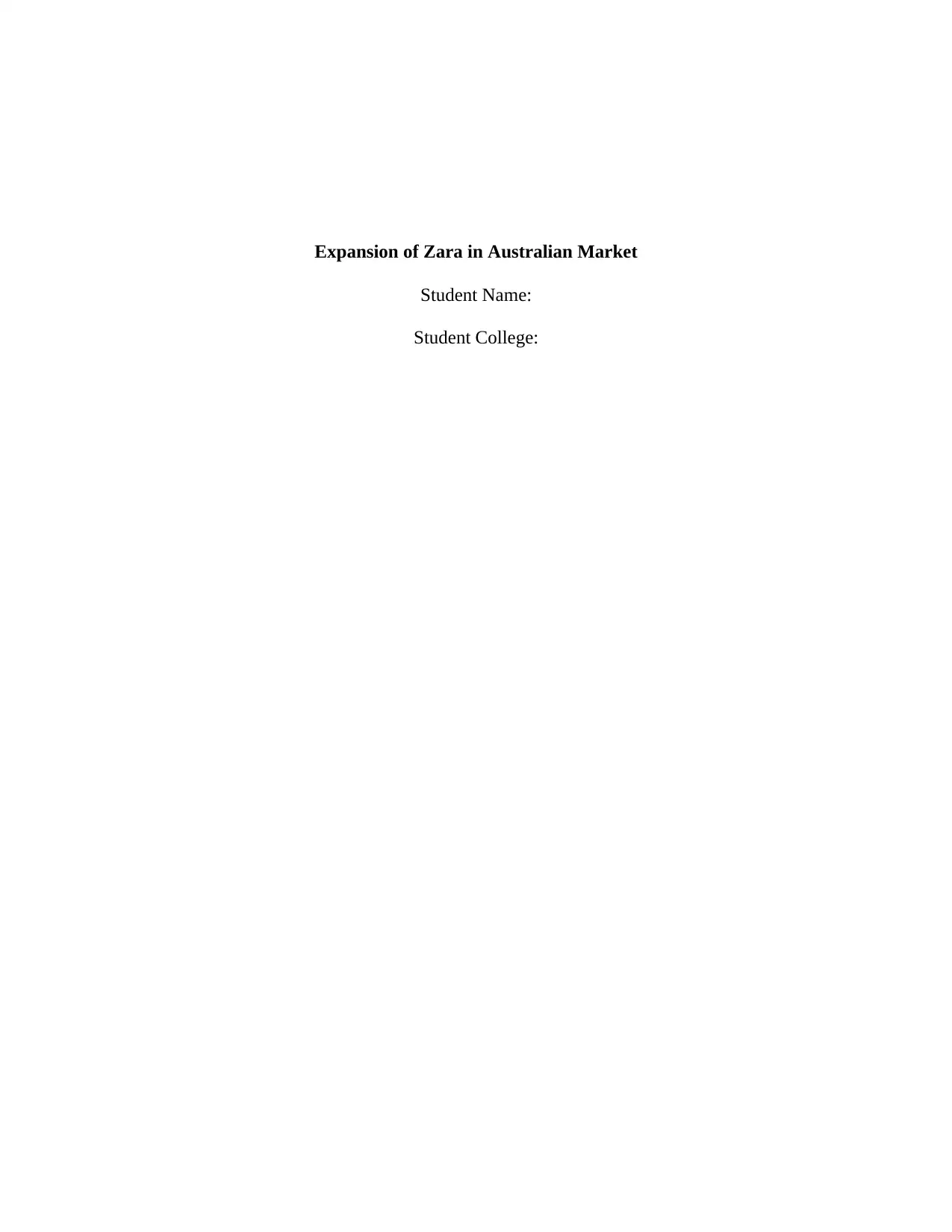
Expansion of Zara in Australian Market
Student Name:
Student College:
Student Name:
Student College:
Paraphrase This Document
Need a fresh take? Get an instant paraphrase of this document with our AI Paraphraser
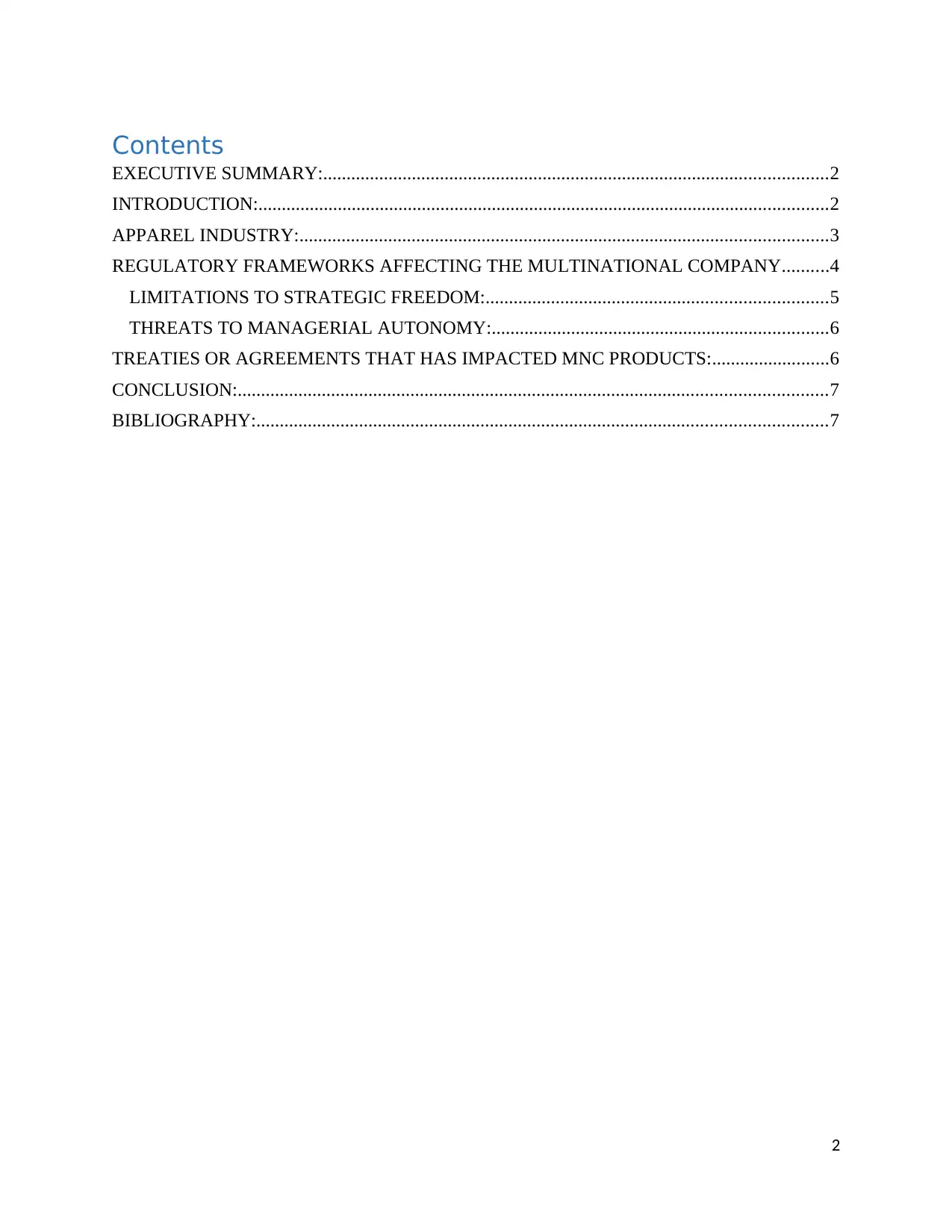
Contents
EXECUTIVE SUMMARY:............................................................................................................2
INTRODUCTION:..........................................................................................................................2
APPAREL INDUSTRY:.................................................................................................................3
REGULATORY FRAMEWORKS AFFECTING THE MULTINATIONAL COMPANY..........4
LIMITATIONS TO STRATEGIC FREEDOM:.........................................................................5
THREATS TO MANAGERIAL AUTONOMY:........................................................................6
TREATIES OR AGREEMENTS THAT HAS IMPACTED MNC PRODUCTS:.........................6
CONCLUSION:..............................................................................................................................7
BIBLIOGRAPHY:..........................................................................................................................7
2
EXECUTIVE SUMMARY:............................................................................................................2
INTRODUCTION:..........................................................................................................................2
APPAREL INDUSTRY:.................................................................................................................3
REGULATORY FRAMEWORKS AFFECTING THE MULTINATIONAL COMPANY..........4
LIMITATIONS TO STRATEGIC FREEDOM:.........................................................................5
THREATS TO MANAGERIAL AUTONOMY:........................................................................6
TREATIES OR AGREEMENTS THAT HAS IMPACTED MNC PRODUCTS:.........................6
CONCLUSION:..............................................................................................................................7
BIBLIOGRAPHY:..........................................................................................................................7
2
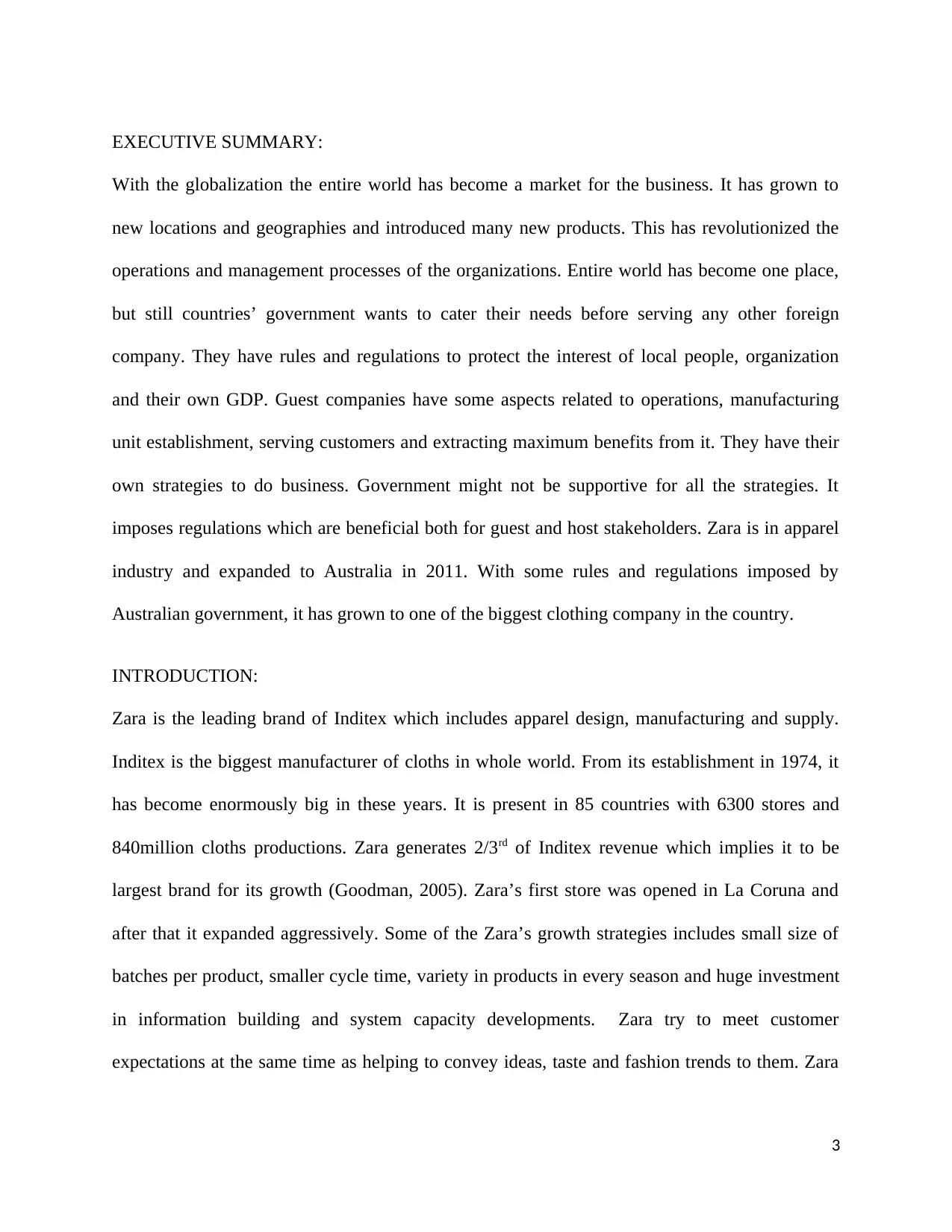
EXECUTIVE SUMMARY:
With the globalization the entire world has become a market for the business. It has grown to
new locations and geographies and introduced many new products. This has revolutionized the
operations and management processes of the organizations. Entire world has become one place,
but still countries’ government wants to cater their needs before serving any other foreign
company. They have rules and regulations to protect the interest of local people, organization
and their own GDP. Guest companies have some aspects related to operations, manufacturing
unit establishment, serving customers and extracting maximum benefits from it. They have their
own strategies to do business. Government might not be supportive for all the strategies. It
imposes regulations which are beneficial both for guest and host stakeholders. Zara is in apparel
industry and expanded to Australia in 2011. With some rules and regulations imposed by
Australian government, it has grown to one of the biggest clothing company in the country.
INTRODUCTION:
Zara is the leading brand of Inditex which includes apparel design, manufacturing and supply.
Inditex is the biggest manufacturer of cloths in whole world. From its establishment in 1974, it
has become enormously big in these years. It is present in 85 countries with 6300 stores and
840million cloths productions. Zara generates 2/3rd of Inditex revenue which implies it to be
largest brand for its growth (Goodman, 2005). Zara’s first store was opened in La Coruna and
after that it expanded aggressively. Some of the Zara’s growth strategies includes small size of
batches per product, smaller cycle time, variety in products in every season and huge investment
in information building and system capacity developments. Zara try to meet customer
expectations at the same time as helping to convey ideas, taste and fashion trends to them. Zara
3
With the globalization the entire world has become a market for the business. It has grown to
new locations and geographies and introduced many new products. This has revolutionized the
operations and management processes of the organizations. Entire world has become one place,
but still countries’ government wants to cater their needs before serving any other foreign
company. They have rules and regulations to protect the interest of local people, organization
and their own GDP. Guest companies have some aspects related to operations, manufacturing
unit establishment, serving customers and extracting maximum benefits from it. They have their
own strategies to do business. Government might not be supportive for all the strategies. It
imposes regulations which are beneficial both for guest and host stakeholders. Zara is in apparel
industry and expanded to Australia in 2011. With some rules and regulations imposed by
Australian government, it has grown to one of the biggest clothing company in the country.
INTRODUCTION:
Zara is the leading brand of Inditex which includes apparel design, manufacturing and supply.
Inditex is the biggest manufacturer of cloths in whole world. From its establishment in 1974, it
has become enormously big in these years. It is present in 85 countries with 6300 stores and
840million cloths productions. Zara generates 2/3rd of Inditex revenue which implies it to be
largest brand for its growth (Goodman, 2005). Zara’s first store was opened in La Coruna and
after that it expanded aggressively. Some of the Zara’s growth strategies includes small size of
batches per product, smaller cycle time, variety in products in every season and huge investment
in information building and system capacity developments. Zara try to meet customer
expectations at the same time as helping to convey ideas, taste and fashion trends to them. Zara
3
⊘ This is a preview!⊘
Do you want full access?
Subscribe today to unlock all pages.

Trusted by 1+ million students worldwide
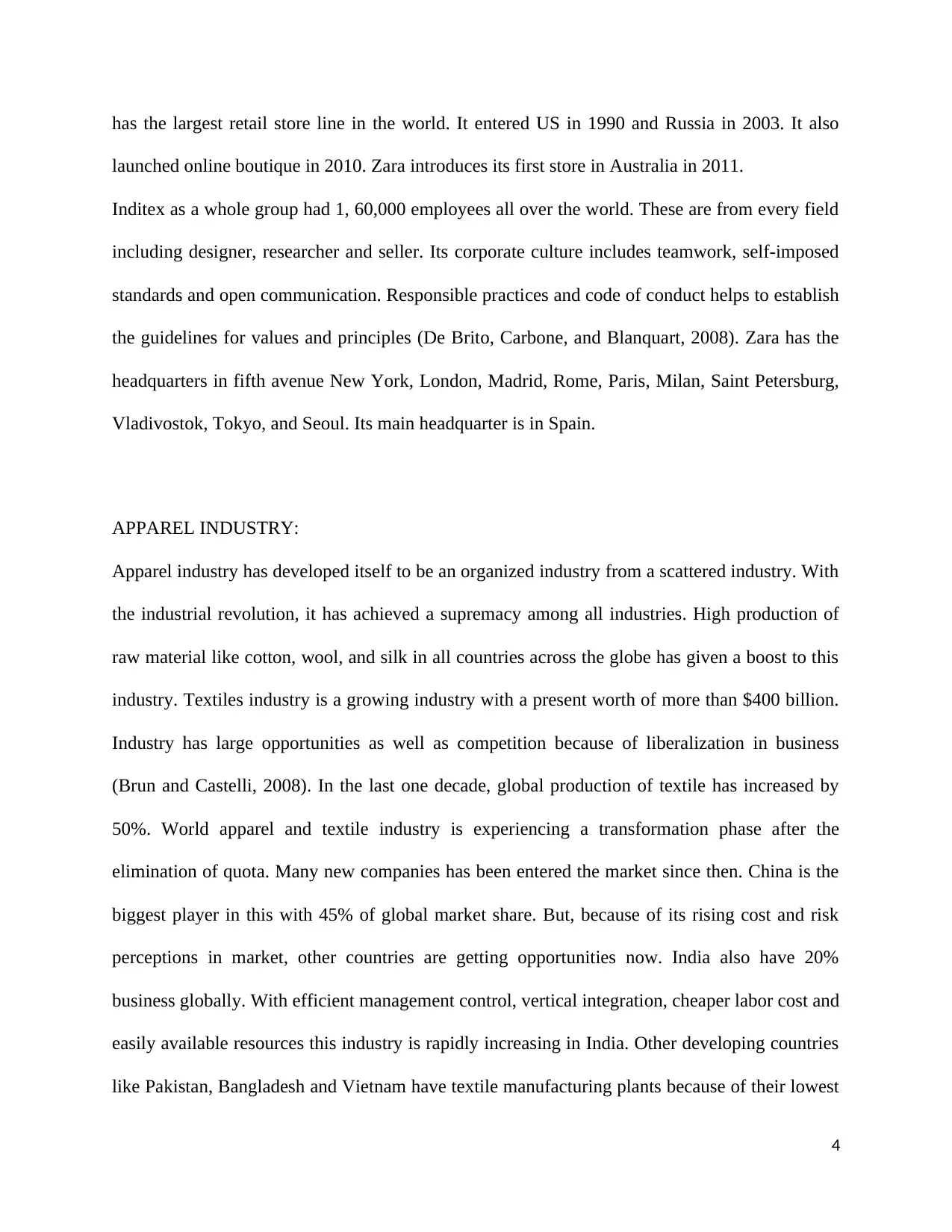
has the largest retail store line in the world. It entered US in 1990 and Russia in 2003. It also
launched online boutique in 2010. Zara introduces its first store in Australia in 2011.
Inditex as a whole group had 1, 60,000 employees all over the world. These are from every field
including designer, researcher and seller. Its corporate culture includes teamwork, self-imposed
standards and open communication. Responsible practices and code of conduct helps to establish
the guidelines for values and principles (De Brito, Carbone, and Blanquart, 2008). Zara has the
headquarters in fifth avenue New York, London, Madrid, Rome, Paris, Milan, Saint Petersburg,
Vladivostok, Tokyo, and Seoul. Its main headquarter is in Spain.
APPAREL INDUSTRY:
Apparel industry has developed itself to be an organized industry from a scattered industry. With
the industrial revolution, it has achieved a supremacy among all industries. High production of
raw material like cotton, wool, and silk in all countries across the globe has given a boost to this
industry. Textiles industry is a growing industry with a present worth of more than $400 billion.
Industry has large opportunities as well as competition because of liberalization in business
(Brun and Castelli, 2008). In the last one decade, global production of textile has increased by
50%. World apparel and textile industry is experiencing a transformation phase after the
elimination of quota. Many new companies has been entered the market since then. China is the
biggest player in this with 45% of global market share. But, because of its rising cost and risk
perceptions in market, other countries are getting opportunities now. India also have 20%
business globally. With efficient management control, vertical integration, cheaper labor cost and
easily available resources this industry is rapidly increasing in India. Other developing countries
like Pakistan, Bangladesh and Vietnam have textile manufacturing plants because of their lowest
4
launched online boutique in 2010. Zara introduces its first store in Australia in 2011.
Inditex as a whole group had 1, 60,000 employees all over the world. These are from every field
including designer, researcher and seller. Its corporate culture includes teamwork, self-imposed
standards and open communication. Responsible practices and code of conduct helps to establish
the guidelines for values and principles (De Brito, Carbone, and Blanquart, 2008). Zara has the
headquarters in fifth avenue New York, London, Madrid, Rome, Paris, Milan, Saint Petersburg,
Vladivostok, Tokyo, and Seoul. Its main headquarter is in Spain.
APPAREL INDUSTRY:
Apparel industry has developed itself to be an organized industry from a scattered industry. With
the industrial revolution, it has achieved a supremacy among all industries. High production of
raw material like cotton, wool, and silk in all countries across the globe has given a boost to this
industry. Textiles industry is a growing industry with a present worth of more than $400 billion.
Industry has large opportunities as well as competition because of liberalization in business
(Brun and Castelli, 2008). In the last one decade, global production of textile has increased by
50%. World apparel and textile industry is experiencing a transformation phase after the
elimination of quota. Many new companies has been entered the market since then. China is the
biggest player in this with 45% of global market share. But, because of its rising cost and risk
perceptions in market, other countries are getting opportunities now. India also have 20%
business globally. With efficient management control, vertical integration, cheaper labor cost and
easily available resources this industry is rapidly increasing in India. Other developing countries
like Pakistan, Bangladesh and Vietnam have textile manufacturing plants because of their lowest
4
Paraphrase This Document
Need a fresh take? Get an instant paraphrase of this document with our AI Paraphraser
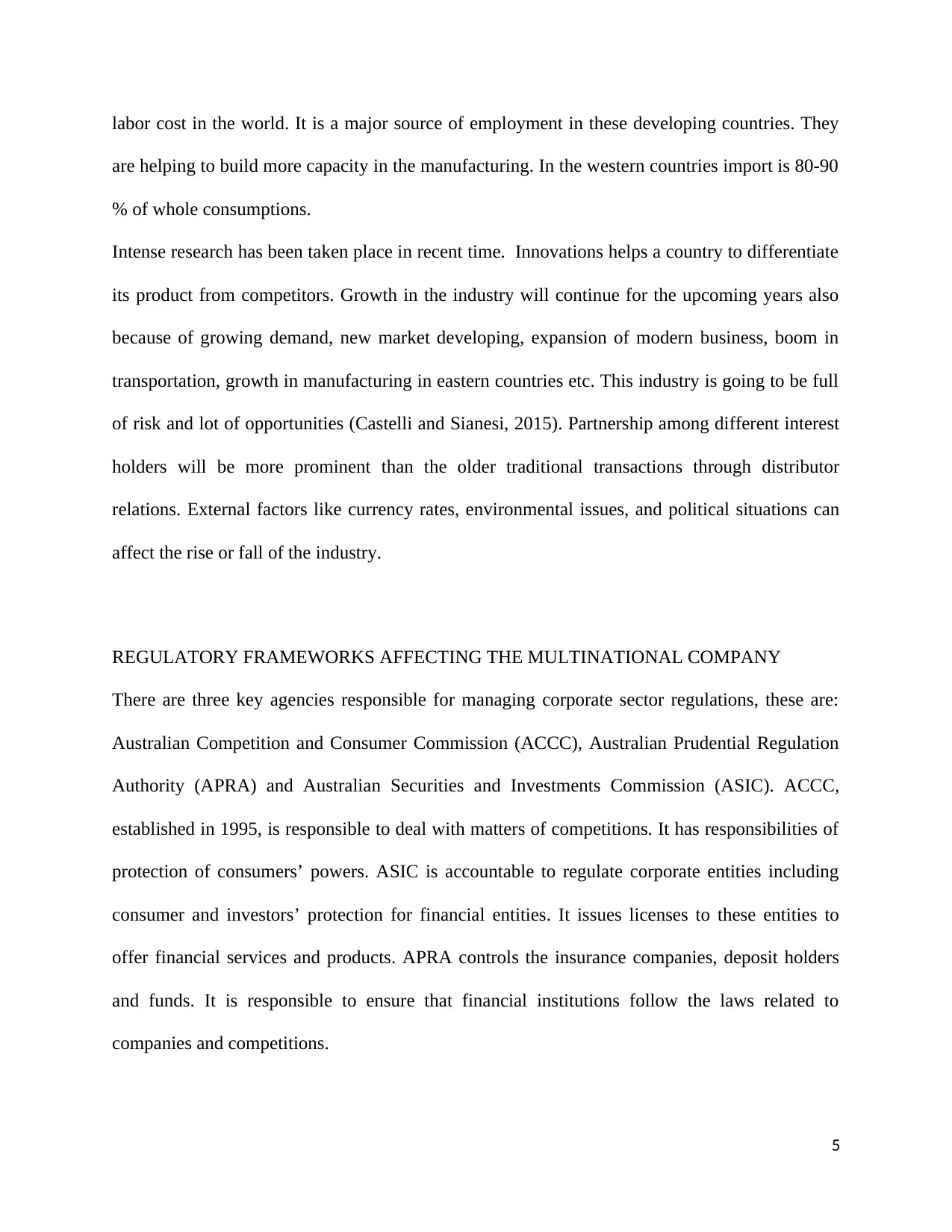
labor cost in the world. It is a major source of employment in these developing countries. They
are helping to build more capacity in the manufacturing. In the western countries import is 80-90
% of whole consumptions.
Intense research has been taken place in recent time. Innovations helps a country to differentiate
its product from competitors. Growth in the industry will continue for the upcoming years also
because of growing demand, new market developing, expansion of modern business, boom in
transportation, growth in manufacturing in eastern countries etc. This industry is going to be full
of risk and lot of opportunities (Castelli and Sianesi, 2015). Partnership among different interest
holders will be more prominent than the older traditional transactions through distributor
relations. External factors like currency rates, environmental issues, and political situations can
affect the rise or fall of the industry.
REGULATORY FRAMEWORKS AFFECTING THE MULTINATIONAL COMPANY
There are three key agencies responsible for managing corporate sector regulations, these are:
Australian Competition and Consumer Commission (ACCC), Australian Prudential Regulation
Authority (APRA) and Australian Securities and Investments Commission (ASIC). ACCC,
established in 1995, is responsible to deal with matters of competitions. It has responsibilities of
protection of consumers’ powers. ASIC is accountable to regulate corporate entities including
consumer and investors’ protection for financial entities. It issues licenses to these entities to
offer financial services and products. APRA controls the insurance companies, deposit holders
and funds. It is responsible to ensure that financial institutions follow the laws related to
companies and competitions.
5
are helping to build more capacity in the manufacturing. In the western countries import is 80-90
% of whole consumptions.
Intense research has been taken place in recent time. Innovations helps a country to differentiate
its product from competitors. Growth in the industry will continue for the upcoming years also
because of growing demand, new market developing, expansion of modern business, boom in
transportation, growth in manufacturing in eastern countries etc. This industry is going to be full
of risk and lot of opportunities (Castelli and Sianesi, 2015). Partnership among different interest
holders will be more prominent than the older traditional transactions through distributor
relations. External factors like currency rates, environmental issues, and political situations can
affect the rise or fall of the industry.
REGULATORY FRAMEWORKS AFFECTING THE MULTINATIONAL COMPANY
There are three key agencies responsible for managing corporate sector regulations, these are:
Australian Competition and Consumer Commission (ACCC), Australian Prudential Regulation
Authority (APRA) and Australian Securities and Investments Commission (ASIC). ACCC,
established in 1995, is responsible to deal with matters of competitions. It has responsibilities of
protection of consumers’ powers. ASIC is accountable to regulate corporate entities including
consumer and investors’ protection for financial entities. It issues licenses to these entities to
offer financial services and products. APRA controls the insurance companies, deposit holders
and funds. It is responsible to ensure that financial institutions follow the laws related to
companies and competitions.
5
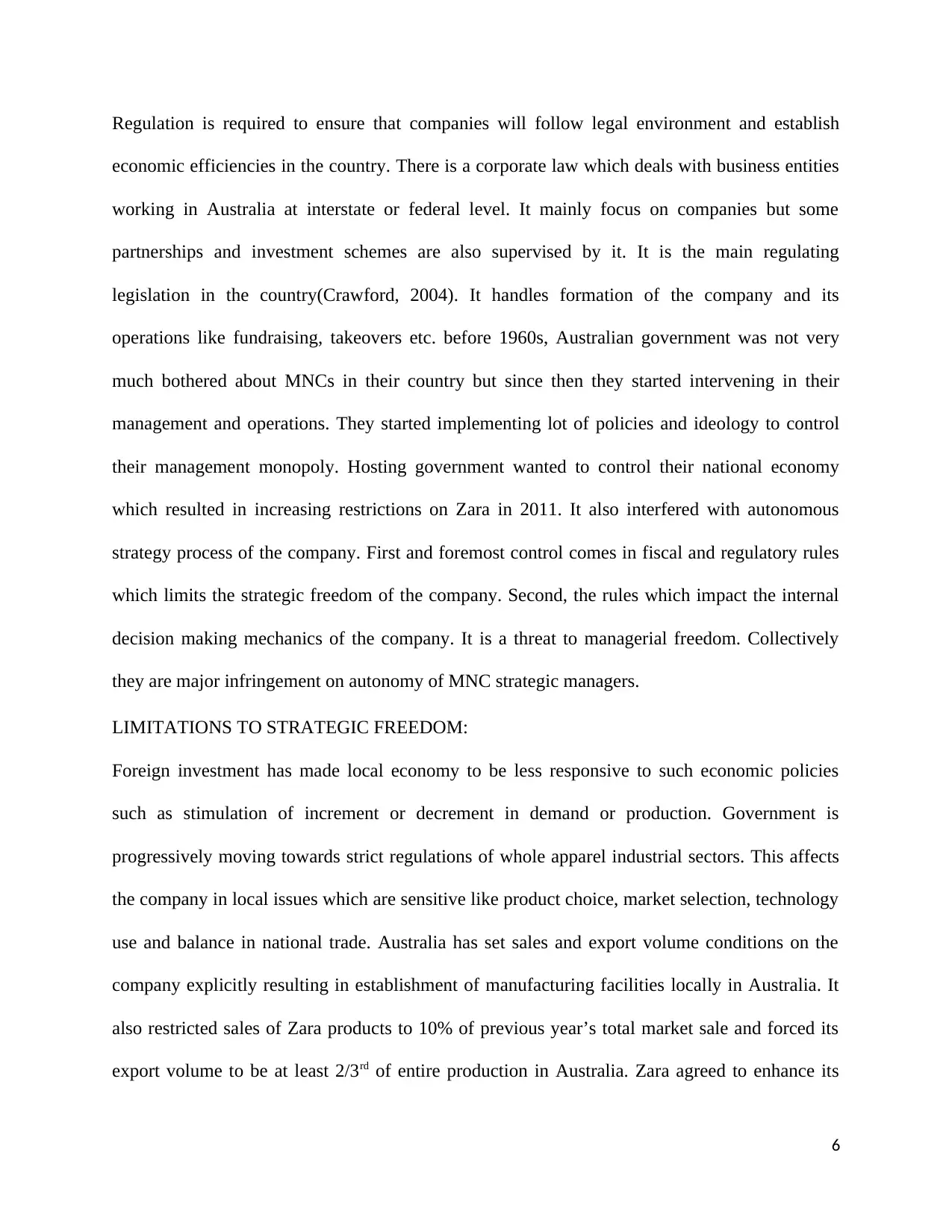
Regulation is required to ensure that companies will follow legal environment and establish
economic efficiencies in the country. There is a corporate law which deals with business entities
working in Australia at interstate or federal level. It mainly focus on companies but some
partnerships and investment schemes are also supervised by it. It is the main regulating
legislation in the country(Crawford, 2004). It handles formation of the company and its
operations like fundraising, takeovers etc. before 1960s, Australian government was not very
much bothered about MNCs in their country but since then they started intervening in their
management and operations. They started implementing lot of policies and ideology to control
their management monopoly. Hosting government wanted to control their national economy
which resulted in increasing restrictions on Zara in 2011. It also interfered with autonomous
strategy process of the company. First and foremost control comes in fiscal and regulatory rules
which limits the strategic freedom of the company. Second, the rules which impact the internal
decision making mechanics of the company. It is a threat to managerial freedom. Collectively
they are major infringement on autonomy of MNC strategic managers.
LIMITATIONS TO STRATEGIC FREEDOM:
Foreign investment has made local economy to be less responsive to such economic policies
such as stimulation of increment or decrement in demand or production. Government is
progressively moving towards strict regulations of whole apparel industrial sectors. This affects
the company in local issues which are sensitive like product choice, market selection, technology
use and balance in national trade. Australia has set sales and export volume conditions on the
company explicitly resulting in establishment of manufacturing facilities locally in Australia. It
also restricted sales of Zara products to 10% of previous year’s total market sale and forced its
export volume to be at least 2/3rd of entire production in Australia. Zara agreed to enhance its
6
economic efficiencies in the country. There is a corporate law which deals with business entities
working in Australia at interstate or federal level. It mainly focus on companies but some
partnerships and investment schemes are also supervised by it. It is the main regulating
legislation in the country(Crawford, 2004). It handles formation of the company and its
operations like fundraising, takeovers etc. before 1960s, Australian government was not very
much bothered about MNCs in their country but since then they started intervening in their
management and operations. They started implementing lot of policies and ideology to control
their management monopoly. Hosting government wanted to control their national economy
which resulted in increasing restrictions on Zara in 2011. It also interfered with autonomous
strategy process of the company. First and foremost control comes in fiscal and regulatory rules
which limits the strategic freedom of the company. Second, the rules which impact the internal
decision making mechanics of the company. It is a threat to managerial freedom. Collectively
they are major infringement on autonomy of MNC strategic managers.
LIMITATIONS TO STRATEGIC FREEDOM:
Foreign investment has made local economy to be less responsive to such economic policies
such as stimulation of increment or decrement in demand or production. Government is
progressively moving towards strict regulations of whole apparel industrial sectors. This affects
the company in local issues which are sensitive like product choice, market selection, technology
use and balance in national trade. Australia has set sales and export volume conditions on the
company explicitly resulting in establishment of manufacturing facilities locally in Australia. It
also restricted sales of Zara products to 10% of previous year’s total market sale and forced its
export volume to be at least 2/3rd of entire production in Australia. Zara agreed to enhance its
6
⊘ This is a preview!⊘
Do you want full access?
Subscribe today to unlock all pages.

Trusted by 1+ million students worldwide
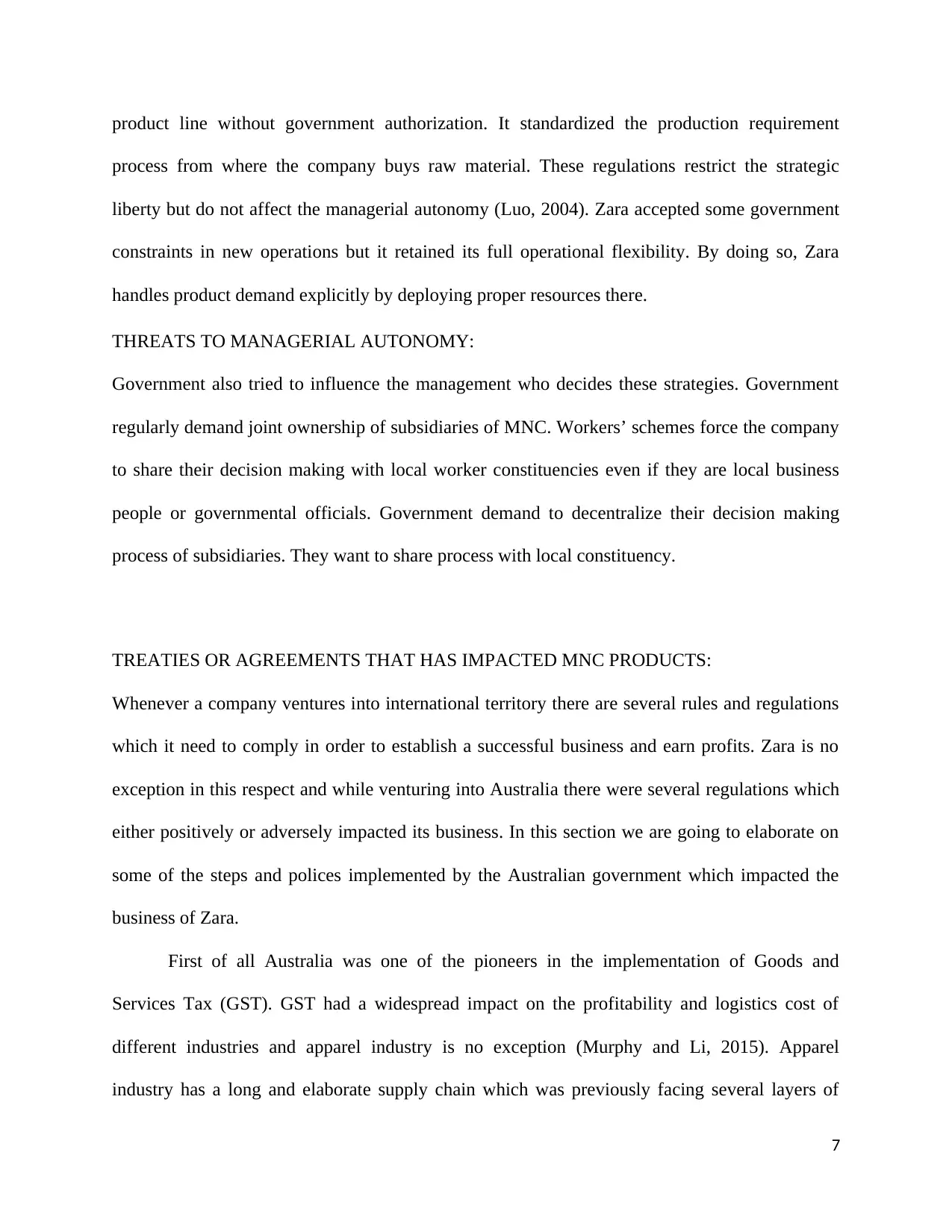
product line without government authorization. It standardized the production requirement
process from where the company buys raw material. These regulations restrict the strategic
liberty but do not affect the managerial autonomy (Luo, 2004). Zara accepted some government
constraints in new operations but it retained its full operational flexibility. By doing so, Zara
handles product demand explicitly by deploying proper resources there.
THREATS TO MANAGERIAL AUTONOMY:
Government also tried to influence the management who decides these strategies. Government
regularly demand joint ownership of subsidiaries of MNC. Workers’ schemes force the company
to share their decision making with local worker constituencies even if they are local business
people or governmental officials. Government demand to decentralize their decision making
process of subsidiaries. They want to share process with local constituency.
TREATIES OR AGREEMENTS THAT HAS IMPACTED MNC PRODUCTS:
Whenever a company ventures into international territory there are several rules and regulations
which it need to comply in order to establish a successful business and earn profits. Zara is no
exception in this respect and while venturing into Australia there were several regulations which
either positively or adversely impacted its business. In this section we are going to elaborate on
some of the steps and polices implemented by the Australian government which impacted the
business of Zara.
First of all Australia was one of the pioneers in the implementation of Goods and
Services Tax (GST). GST had a widespread impact on the profitability and logistics cost of
different industries and apparel industry is no exception (Murphy and Li, 2015). Apparel
industry has a long and elaborate supply chain which was previously facing several layers of
7
process from where the company buys raw material. These regulations restrict the strategic
liberty but do not affect the managerial autonomy (Luo, 2004). Zara accepted some government
constraints in new operations but it retained its full operational flexibility. By doing so, Zara
handles product demand explicitly by deploying proper resources there.
THREATS TO MANAGERIAL AUTONOMY:
Government also tried to influence the management who decides these strategies. Government
regularly demand joint ownership of subsidiaries of MNC. Workers’ schemes force the company
to share their decision making with local worker constituencies even if they are local business
people or governmental officials. Government demand to decentralize their decision making
process of subsidiaries. They want to share process with local constituency.
TREATIES OR AGREEMENTS THAT HAS IMPACTED MNC PRODUCTS:
Whenever a company ventures into international territory there are several rules and regulations
which it need to comply in order to establish a successful business and earn profits. Zara is no
exception in this respect and while venturing into Australia there were several regulations which
either positively or adversely impacted its business. In this section we are going to elaborate on
some of the steps and polices implemented by the Australian government which impacted the
business of Zara.
First of all Australia was one of the pioneers in the implementation of Goods and
Services Tax (GST). GST had a widespread impact on the profitability and logistics cost of
different industries and apparel industry is no exception (Murphy and Li, 2015). Apparel
industry has a long and elaborate supply chain which was previously facing several layers of
7
Paraphrase This Document
Need a fresh take? Get an instant paraphrase of this document with our AI Paraphraser
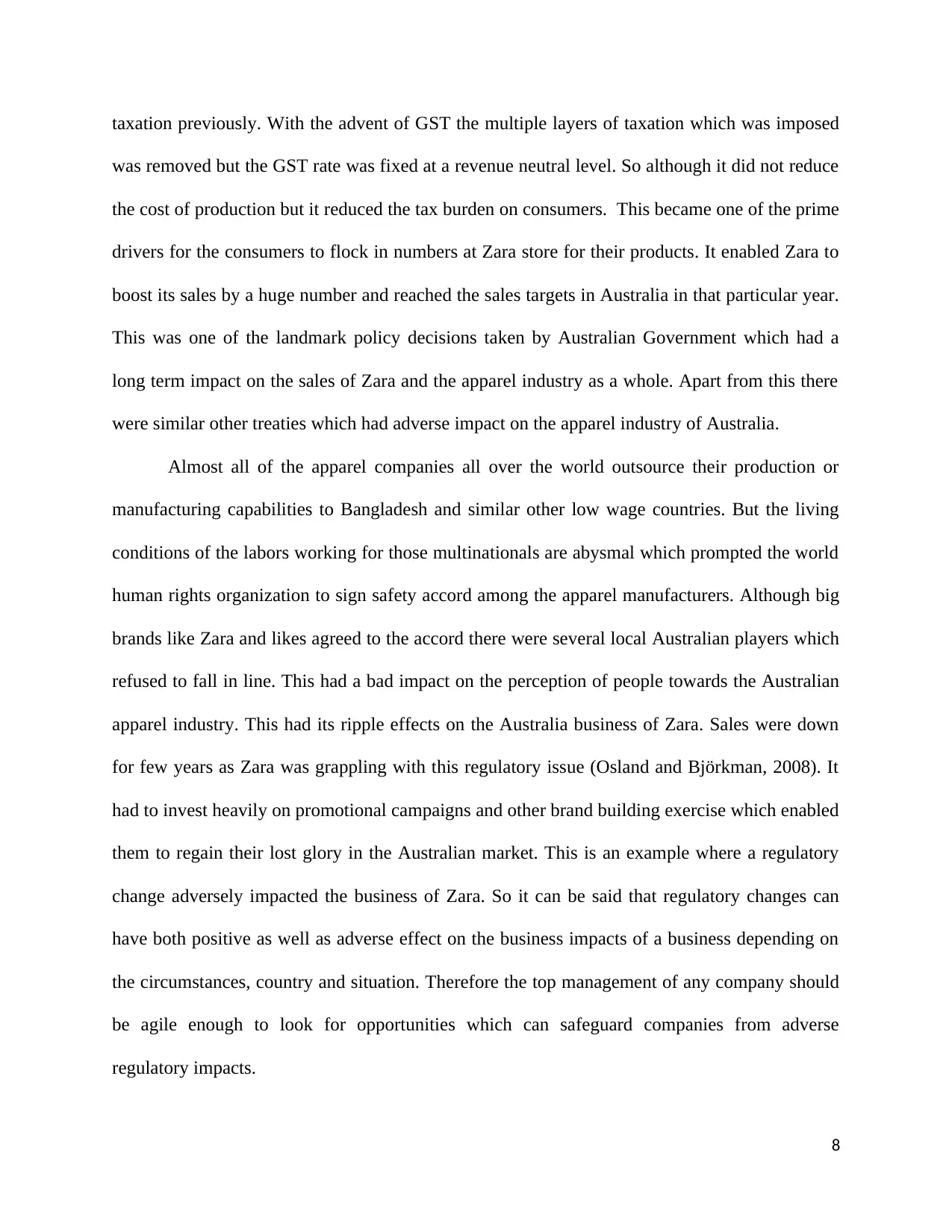
taxation previously. With the advent of GST the multiple layers of taxation which was imposed
was removed but the GST rate was fixed at a revenue neutral level. So although it did not reduce
the cost of production but it reduced the tax burden on consumers. This became one of the prime
drivers for the consumers to flock in numbers at Zara store for their products. It enabled Zara to
boost its sales by a huge number and reached the sales targets in Australia in that particular year.
This was one of the landmark policy decisions taken by Australian Government which had a
long term impact on the sales of Zara and the apparel industry as a whole. Apart from this there
were similar other treaties which had adverse impact on the apparel industry of Australia.
Almost all of the apparel companies all over the world outsource their production or
manufacturing capabilities to Bangladesh and similar other low wage countries. But the living
conditions of the labors working for those multinationals are abysmal which prompted the world
human rights organization to sign safety accord among the apparel manufacturers. Although big
brands like Zara and likes agreed to the accord there were several local Australian players which
refused to fall in line. This had a bad impact on the perception of people towards the Australian
apparel industry. This had its ripple effects on the Australia business of Zara. Sales were down
for few years as Zara was grappling with this regulatory issue (Osland and Björkman, 2008). It
had to invest heavily on promotional campaigns and other brand building exercise which enabled
them to regain their lost glory in the Australian market. This is an example where a regulatory
change adversely impacted the business of Zara. So it can be said that regulatory changes can
have both positive as well as adverse effect on the business impacts of a business depending on
the circumstances, country and situation. Therefore the top management of any company should
be agile enough to look for opportunities which can safeguard companies from adverse
regulatory impacts.
8
was removed but the GST rate was fixed at a revenue neutral level. So although it did not reduce
the cost of production but it reduced the tax burden on consumers. This became one of the prime
drivers for the consumers to flock in numbers at Zara store for their products. It enabled Zara to
boost its sales by a huge number and reached the sales targets in Australia in that particular year.
This was one of the landmark policy decisions taken by Australian Government which had a
long term impact on the sales of Zara and the apparel industry as a whole. Apart from this there
were similar other treaties which had adverse impact on the apparel industry of Australia.
Almost all of the apparel companies all over the world outsource their production or
manufacturing capabilities to Bangladesh and similar other low wage countries. But the living
conditions of the labors working for those multinationals are abysmal which prompted the world
human rights organization to sign safety accord among the apparel manufacturers. Although big
brands like Zara and likes agreed to the accord there were several local Australian players which
refused to fall in line. This had a bad impact on the perception of people towards the Australian
apparel industry. This had its ripple effects on the Australia business of Zara. Sales were down
for few years as Zara was grappling with this regulatory issue (Osland and Björkman, 2008). It
had to invest heavily on promotional campaigns and other brand building exercise which enabled
them to regain their lost glory in the Australian market. This is an example where a regulatory
change adversely impacted the business of Zara. So it can be said that regulatory changes can
have both positive as well as adverse effect on the business impacts of a business depending on
the circumstances, country and situation. Therefore the top management of any company should
be agile enough to look for opportunities which can safeguard companies from adverse
regulatory impacts.
8
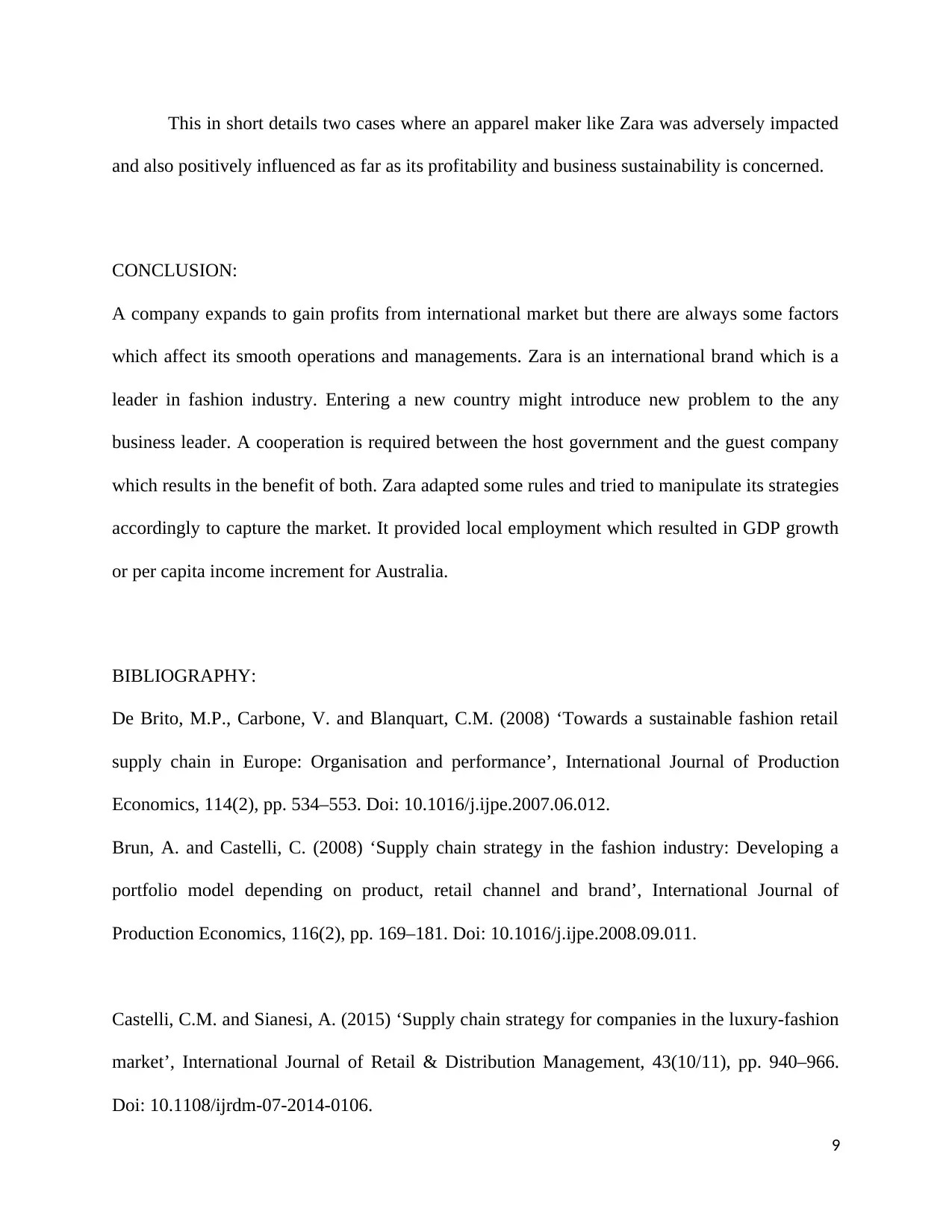
This in short details two cases where an apparel maker like Zara was adversely impacted
and also positively influenced as far as its profitability and business sustainability is concerned.
CONCLUSION:
A company expands to gain profits from international market but there are always some factors
which affect its smooth operations and managements. Zara is an international brand which is a
leader in fashion industry. Entering a new country might introduce new problem to the any
business leader. A cooperation is required between the host government and the guest company
which results in the benefit of both. Zara adapted some rules and tried to manipulate its strategies
accordingly to capture the market. It provided local employment which resulted in GDP growth
or per capita income increment for Australia.
BIBLIOGRAPHY:
De Brito, M.P., Carbone, V. and Blanquart, C.M. (2008) ‘Towards a sustainable fashion retail
supply chain in Europe: Organisation and performance’, International Journal of Production
Economics, 114(2), pp. 534–553. Doi: 10.1016/j.ijpe.2007.06.012.
Brun, A. and Castelli, C. (2008) ‘Supply chain strategy in the fashion industry: Developing a
portfolio model depending on product, retail channel and brand’, International Journal of
Production Economics, 116(2), pp. 169–181. Doi: 10.1016/j.ijpe.2008.09.011.
Castelli, C.M. and Sianesi, A. (2015) ‘Supply chain strategy for companies in the luxury-fashion
market’, International Journal of Retail & Distribution Management, 43(10/11), pp. 940–966.
Doi: 10.1108/ijrdm-07-2014-0106.
9
and also positively influenced as far as its profitability and business sustainability is concerned.
CONCLUSION:
A company expands to gain profits from international market but there are always some factors
which affect its smooth operations and managements. Zara is an international brand which is a
leader in fashion industry. Entering a new country might introduce new problem to the any
business leader. A cooperation is required between the host government and the guest company
which results in the benefit of both. Zara adapted some rules and tried to manipulate its strategies
accordingly to capture the market. It provided local employment which resulted in GDP growth
or per capita income increment for Australia.
BIBLIOGRAPHY:
De Brito, M.P., Carbone, V. and Blanquart, C.M. (2008) ‘Towards a sustainable fashion retail
supply chain in Europe: Organisation and performance’, International Journal of Production
Economics, 114(2), pp. 534–553. Doi: 10.1016/j.ijpe.2007.06.012.
Brun, A. and Castelli, C. (2008) ‘Supply chain strategy in the fashion industry: Developing a
portfolio model depending on product, retail channel and brand’, International Journal of
Production Economics, 116(2), pp. 169–181. Doi: 10.1016/j.ijpe.2008.09.011.
Castelli, C.M. and Sianesi, A. (2015) ‘Supply chain strategy for companies in the luxury-fashion
market’, International Journal of Retail & Distribution Management, 43(10/11), pp. 940–966.
Doi: 10.1108/ijrdm-07-2014-0106.
9
⊘ This is a preview!⊘
Do you want full access?
Subscribe today to unlock all pages.

Trusted by 1+ million students worldwide
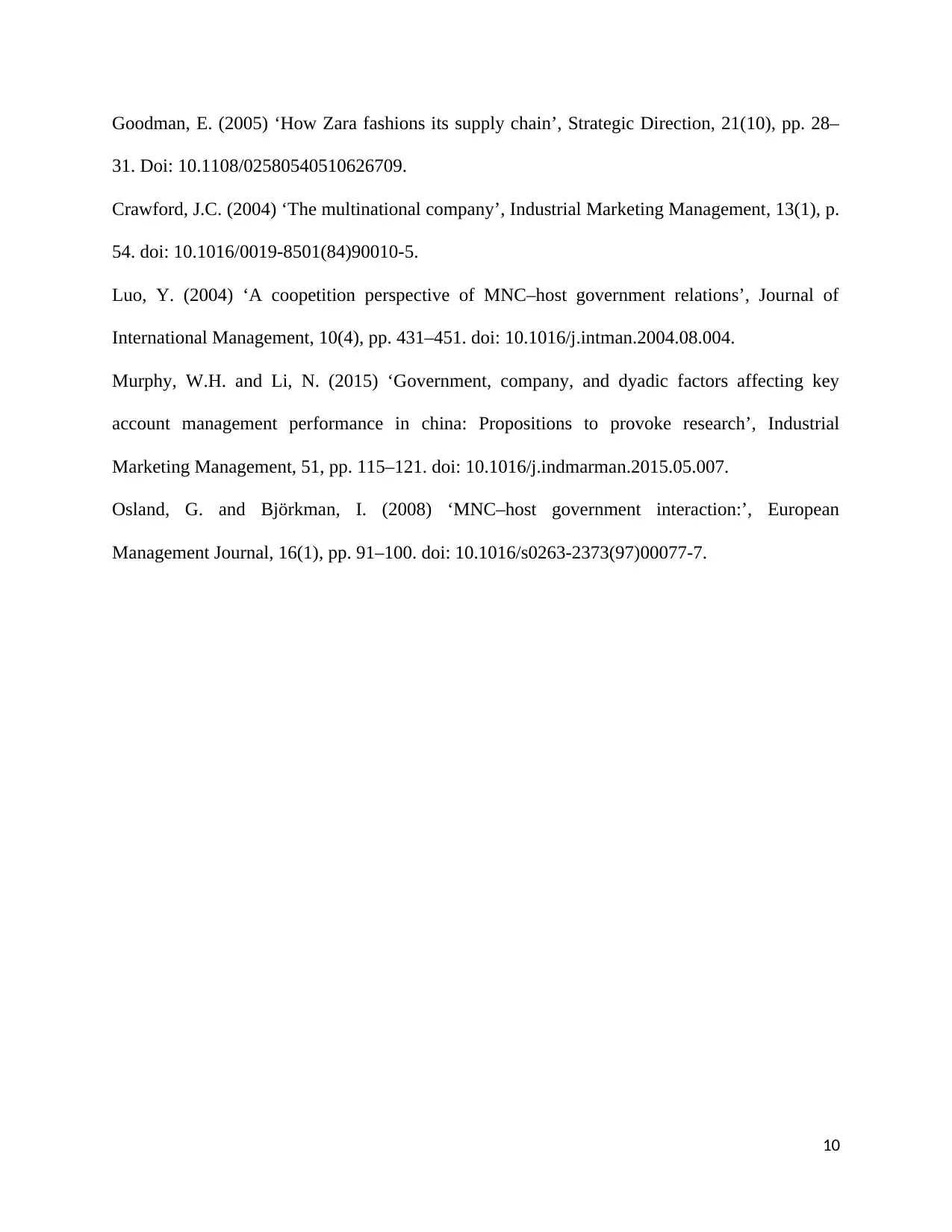
Goodman, E. (2005) ‘How Zara fashions its supply chain’, Strategic Direction, 21(10), pp. 28–
31. Doi: 10.1108/02580540510626709.
Crawford, J.C. (2004) ‘The multinational company’, Industrial Marketing Management, 13(1), p.
54. doi: 10.1016/0019-8501(84)90010-5.
Luo, Y. (2004) ‘A coopetition perspective of MNC–host government relations’, Journal of
International Management, 10(4), pp. 431–451. doi: 10.1016/j.intman.2004.08.004.
Murphy, W.H. and Li, N. (2015) ‘Government, company, and dyadic factors affecting key
account management performance in china: Propositions to provoke research’, Industrial
Marketing Management, 51, pp. 115–121. doi: 10.1016/j.indmarman.2015.05.007.
Osland, G. and Björkman, I. (2008) ‘MNC–host government interaction:’, European
Management Journal, 16(1), pp. 91–100. doi: 10.1016/s0263-2373(97)00077-7.
10
31. Doi: 10.1108/02580540510626709.
Crawford, J.C. (2004) ‘The multinational company’, Industrial Marketing Management, 13(1), p.
54. doi: 10.1016/0019-8501(84)90010-5.
Luo, Y. (2004) ‘A coopetition perspective of MNC–host government relations’, Journal of
International Management, 10(4), pp. 431–451. doi: 10.1016/j.intman.2004.08.004.
Murphy, W.H. and Li, N. (2015) ‘Government, company, and dyadic factors affecting key
account management performance in china: Propositions to provoke research’, Industrial
Marketing Management, 51, pp. 115–121. doi: 10.1016/j.indmarman.2015.05.007.
Osland, G. and Björkman, I. (2008) ‘MNC–host government interaction:’, European
Management Journal, 16(1), pp. 91–100. doi: 10.1016/s0263-2373(97)00077-7.
10
1 out of 10
Related Documents
Your All-in-One AI-Powered Toolkit for Academic Success.
+13062052269
info@desklib.com
Available 24*7 on WhatsApp / Email
![[object Object]](/_next/static/media/star-bottom.7253800d.svg)
Unlock your academic potential
Copyright © 2020–2025 A2Z Services. All Rights Reserved. Developed and managed by ZUCOL.




